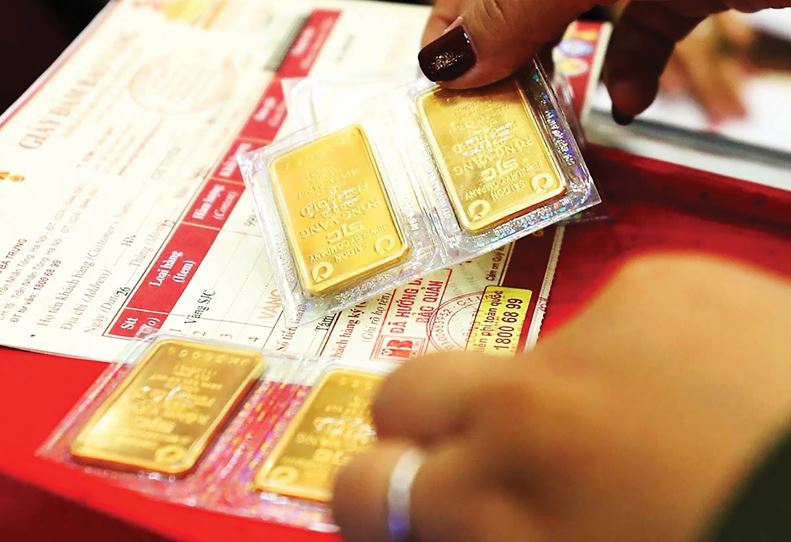Gold market must operates transparently
Vietnam’s gold market has been operated more efficiently since Decree No. 24 was issued in 2012.

Thirteen years after its release, Decree No. 24/2012/ND-CP on gold business activities remains relevant after having removed gold from banking credit activities and preventing the “goldenization” of Vietnam’s economy. However, the question that remains is how to redirect gold into production and business activities, rather than hoarding and hiding it in illicit transactions, and there is still no clear answer.
Prior to 2012, gold was widely used in transactions involving the purchase of houses, land, and vehicles, and repaying loans. Decree No. 174/1999/ND-CP, dated December 9, 1999, limited the State Bank of Vietnam (SBV)’s authority to manage monetary gold within foreign exchange reserves, while non-monetary gold (such as gold bullion and jewelry) was allowed to be freely traded like any other commodity. On October 13, 2000, the SBV issued Decision No. 432/2000/QD-NHNN, which implicitly recognized “gold credit” within commercial banks and in its own policy operations. As a result, in the “money-goods” relationship, gold held a dominant position as a means of payment alongside VND and USD, and was officially incorporated into banking credit activities.
From boom to breakdown
With such a regulatory environment, banks were free to trade, mobilize, and lend both physical gold and gold on account. As a result, gold trading platforms flourished, ranging from banks to unofficial websites. The “goldenization” of the economy could have continued, with participants reaping substantial profits, had it not been for the 2007 financial crisis, which triggered a downwards spiral.
Between 2007 and 2009, Vietnam’s economy became more integrated with the global market. By 2009, total import-export turnover reached $125.4 billion, equivalent to 119.89 per cent of GDP. Strong foreign capital inflows meant that fluctuations in global financial markets or commodity prices quickly impacted Vietnam.
In September 2009, global gold prices surged to $1,227.50 an ounce. Factors included central banks increasing gold purchases, a weakening USD, speculative buying, and inflation concerns. Domestically, on November 11, 2009, gold bullion prices hit a peak of VND29.3 million ($1,172) per tael (one tael equals 37.5 grams, or 1.2 ounces), or around VND4-5 million ($160-$200) higher than global prices. Analysts attributed this gap to the government’s 2008 decision to suspend gold imports to maintain macro-economic balances, particularly exchange rate stability.
As gold prices climbed, banks with heavy exposure to physical and account-based gold faced serious challenges. In 2007, SJC gold bars were priced at VND12.255 million to VND12.290 million ($490.20 to $491.60) per tael. By 2009, the price had more than doubled to VND29.3 million ($1,172), and by 2011, just before the implementation of Decree No. 24, prices reached VND42.6 million per tael; 3.44-times higher than in 2007. No bank predicted such a drastic price surge.
Dr. Nguyen Duc Trung, Rector of the Banking University of Ho Chi Minh City, noted that lax management of non-monetary gold had severe consequences, especially during price volatility. Speculators manipulated prices and created artificial supply shortages, while rumors fueled gold-buying sprees. When domestic gold prices exceeded global levels, illegal activities emerged: foreign currency was hoarded on the black market to smuggle in raw gold, which was turned into bullion, ultimately damaging the exchange rate and foreign currency market.
Challenges and developments
In response to this situation, the SBV advised on and on April 3, 2012, the government issued Decree No. 24/2012/ND-CP on gold business activities, effective from May 25, 2012, with clear objectives: (i) resolving gold liquidity issues; (ii) nationalizing and granting a State monopoly to the SJC gold brand (with over 90 per cent market share); (iii) monopolizing raw gold imports and exports; (iv) gradually removing gold from banking activities, prohibiting gold-backed lending and other forms of gold mobilization, and closing gold trading floors; and (v) allowing gold bar transactions only with SBV-licensed organizations.
The most challenging goal was importing gold to address liquidity issues, especially given limited foreign exchange reserves. While the SBV never disclosed the exact amount, experts have estimated that “the SBV imported 70 to 75 tons of raw gold.”
The SBV organized gold auctions following Circular No. 06/2013/TT-NHNN on March 12, 2013. The first auction saw 2,000 taels sold, with subsequent auctions increasing to 25,700 and 39,200 taels. By May 3, 2013, these auctions helped credit institutions with gold-based lending settle 80 per cent of their mobilized gold balance. By June 30, 2013, all banks had liquidated 100 per cent of their gold holdings.
This gold removal helped stabilize exchange rates and restore banks’ health, allowing them to focus on domestic currency investments. Before the decree, licensed gold producers would illegally import gold when domestic prices exceeded international levels, accumulating foreign currency on the black market.
With tighter market controls, exchange rates stabilized, a trend that has continued since 2013. Researchers observed that after implementing Decree No. 24, the link between gold and USD prices weakened, and exchange rates and inflation remained within the National Assembly (NA)’s targets.
However, from 2020 onwards, global economic shifts significantly impacted gold prices. In a recent report to the NA, the SBV noted that global gold prices hit record highs in early 2025, driven by political instability, military conflicts, increased central bank and investment fund purchases, and tariffs imposed by US President Donald Trump on global trade, which hurt investor sentiment and economic growth.
Domestically, SJC gold prices mirrored global trends. By April 2025, the price gap between domestic and global gold was controlled at VND3-5 million ($120-200) per tael (5-7 per cent).
This raised key questions for the SBV: (i) How can the gold price gap between domestic and international markets be reduced? (ii) Should gold trading be allowed on exchanges? and (iii) How can gold resources be unlocked for socio-economic development? Some argued that Decree No. 24 had “fulfilled its mission” and should be “terminated”, allowing “gold imports to resume based on market demand.”
Improving transparency
According to a former Deputy General Director of a State-owned commercial bank, Vietnam’s foreign exchange reserves are currently lower than those of regional countries with similar economic sizes, like Indonesia, Thailand, and Malaysia, both in absolute value and import coverage. The economy’s heavy reliance on energy imports and raw materials, such as textiles and electronics, puts further pressure on reserves.
Global economic volatility, especially US tax and trade policies under President Trump, has significantly impacted Vietnam’s balance of payments. Maintaining reserves for essential imports like machinery and technology has become more urgent than the need for gold imports for gold bar production.
The gold market has long been distorted by manipulation, as recent audit findings from the SBV reveal. A key factor driving demand for gold bars is not just concerns about inflation and asset storage but also as a means of hiding illicit wealth. As the government pushes for greater asset transparency, gold, which remains unregistered, has become a preferred “asset hiding place.” Unlike bank deposits, securities, and real estate, which are fully tracked, gold transactions are unregistered, making ownership difficult to trace.
Gold smuggling, driven by both economic needs and illicit wealth laundering, continues to thrive, with many recent cases revealing smuggling rings involving hundreds of kilograms of the precious metal. To stabilize the gold market and fight corruption, gold transactions should be made through accounts linked to personal identification codes. All gold transactions should be recorded and tracked, enabling easy identification of asset origin.
A recent SBV audit of six gold market units found little attention paid to large gold transactions between individuals and organizations, even when those individuals had no visible wealth to justify such dealings.







